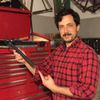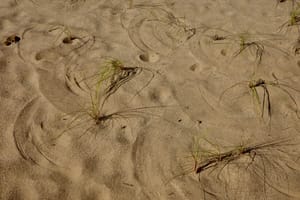It was a pretty good premise for a newsletter: Do your normal work, but take notes the whole time. Open some tabs, write down what you notice about them, and once a week send the whole thing out and see if anyone else enjoys learning along. Meanwhile you're working on something different, something bigger presumably, but it's not quite ready to show people yet and anyway maybe the big project isn't the point. The point is, you're noticing things, and when you notice something — no matter how small it is — you make some effort not to lose it.
Anyway, here it is: All the out-of-scope stuff I've noticed in the past week or so.
- Scope of Work's Reading Group is starting A Thousand Brains: A New Theory of Intelligence by Jeff Hawkins. We'll discuss the book through chapter 4 this Thursday at noon ET in the SOW Members' Slack, and will then work through the book weekly, in roughly 40-page chunks, until we finish it on 2025-12-11. This book (which is available as a PDF here, and is summarized in this 2019 blog post) relates directly to a recent interest of mine, which is understanding how my own sensory data is stitched together into a seemingly-coherent experience; I'm looking forward to chatting with the Reading Group (which, as always, you can join!) about it over the next month and a half ;)
- Here's a 591-word essay, in the Provincetown Independent, about the appeal and execution of a breakfast of freshly-dug oysters Rockefeller. The essay is complete with a step-by-step recipe for Rockefeller sauce, which is made ahead of time and then frozen, to be nuked quickly on the morning the oysters are to be consumed, and then dolloped in "generous spoonfuls" on the just-harvested Wellfleets. This is claimed to produce a "most perfect breakfast" — a claim I am unable to verify, but which I'm interested in investigating.
I found this after spending an afternoon roaming around some sand dunes on eastern Long Island, where I saw the "scratch circles" made by dune grass as it's blown this way and that in the wind. I did not know the term "scratch circles," and one of the few places on the internet that seemed interested in promoting it was the Provincetown Independent, in an article here. Subsequently I found this 2024 academic paper on scratch circles observed in South Africa, including ones made on exposed cliff faces. Some of these date back to the Pleistocene, and some seem to have been made by humans by scratching arcs into the sand with primitive, compass-like tools. - Re: James' heartfelt elegy to factory tours from a few weeks ago, there is now officially an #only-factory-tours channel in the SOW Members' Slack (which you can join here!). Since its creation I've been going through my own catalog of factory photos and trying to remember which of their corresponding NDAs I'm still subject to; then again, the Members' Slack is a semi-private space, and the likelihood is that I'll end up dumping everything into it in the coming weeks.
- The T.S. Golden Bear is a training ship, originally commissioned by the US Navy in 1989, then laid up in the Suisun Bay Reserve Fleet in 1994, then reinstated in 1996 by the US Maritime Administration. It is operated today by the California State University Maritime Academy, which uses it as a "floating classroom." Here's a photo tour of T.S. Golden Bear; it's currently at anchor near the Benicia-Martinez Bridge, in Suisun Bay. T.S. Golden Bear will be replaced by a purpose-built vessel, T.S. Golden State, next year.
- Copra is the dehydrated flesh of coconuts. Pick a mature coconut, split it in half, and lay it out in the sun to dry; the white stuff inside is copra, and can be sold on the commodity market for a couple bucks per kilogram. Whoever buys it will probably expeller-press it, extracting the oil and then reselling the high-protein, high-fiber cake as livestock feed.
- Here's an interesting personal/corporate/technological history of the people, businesses, and techniques used to make monolithic polyurethane-concrete domes.
- The state of Wyoming has 2.4 million acres of "corner-locked" public land, which is to say parcels of public land which are surrounded on all sides by private land, but which are arranged in a checkerboard pattern with other pieces of public land such that their corners are coincident. If no fences are present, you could theoretically jump from one parcel of corner-locked public land to another without trespassing on the private parcels. And the 10th Circuit Court of Appeals just ruled that it's not lawful for private landowners to put up fences that would prevent "corner-hopping," which hunters might do in order to access a corner-locked parcel.
- Methyl anthranilate is an ester of anthranilic acid, and one of the primary compounds behind the distinctive flavor of Concord grapes.
- One of the pleasures of getting old is looking back at something you did in the past, and agreeing with the decision to have done it, but simultaneously having only a vague sense of why you did it at the time. Some time ago — I think I was in my twenties — I purchased a heavy wall Erlenmeyer flask, stamped with the Pyrex trademark, on eBay. I believe I bought it used, and also a heavy wall low-form Griffin beaker, and while I might have claimed to be using them as research for some other product I was "thinking about designing," I mostly just thought they looked cool. The Griffin beaker now holds pens; the Erlenmeyer flask has sometimes been used to prepare a salad dressing. I still think they look very cool, and the other day I dug around the internet and found a 131-page Pyrex catalog, apparently from 1938, of wonderfully hand-drawn lab glassware.
- A porrón is a pitcher, used to drink wine in Catalonia and Valencia, Spain. Porrónes are typically shared by a group; the drinker's lips do not touch their spouts.
In addition to A Thousand Brains, I'm reading (thanks to Avi and Adam) Albert Camus' The Myth of Sisyphus, which apparently instructs us to "imagine Sisyphus happy." I'm also listening to Dan Charnas' Dilla Time, which chronicles the life and enduring impact of the late hip-hop producer and rapper J Dilla. Off the top of my head, my favorite J Dilla tracks are probably (with Common) "E=mc2", and Slum Village's "The Look of Love, Pt. 1", and the Madlib-produced (but still highly swung) "The Official".

I have lost the original quote (it may have been from rock critic Robert Palmer) but I can distinctly recall reading "R&B" being defined as "pop music, which happens to be made by or for Black people." This would have been circa 2012, a time during which I had Frank Ocean's Channel Orange on repeat. Ocean was paraphrased, in a 2012 profile by Sasha Frere-Jones, as saying that the term "R&B" carried "racial connotations;" I would add that at least in the late 1990s, when I became aware of contemporary R&B, the genre also had sexual connotations. This association was made most prominently, and tragically, by D'Angelo, who died last week after battling pancreatic cancer. D'Angelo's 2000 sophomore album Voodoo, which like many people I encountered first in its highly erotic video form, had by this time become one of my most-loved pieces of music — and one that I only vaguely associated with sex. For a couple years its final track, the lullaby-like "Africa," would automatically start playing every time I plugged my iPod into my car's stereo. To call it rhythmic would be almost obtuse; the song rolls, Ahmir (Questlove) Thompson's toms tumbling along as D'Angelo — whose overdubbing on this track is subtler than on the rest of the album — flutters tenderly about protecting the listener "for all eternity."
In the context of the album, "Africa" feels like a coda, its tentative final mission statement. The track's final few seconds (which seem to run the entire album back, in reverse) reinforce this reading, which in a way is self-evident: "Africa" is the mood that D'Angelo wanted to leave his listeners with. And leave them he did, retreating shortly after the album's release to, as he apparently told Questlove around this time, "go in the woods, drink some hooch, grow a beard and get fat." He didn't release another record until 2014, when he reemerged with the more distorted and much less sexual Black Messiah — his final of only three full studio albums. As Justin Charity wrote in The Ringer, "We'd come to terms with D'Angelo being a rare cosmological event."
D'Angelo was, ultimately, a victim of his own success as an artist. His gifts as a musician, and the intense effort he put into his recording sessions, resulted in artwork that compels a wide range of emotional responses. One of those responses is erotic, and in the end the erotic aspects of "Untitled (How Does It Feel)" came to dominate public conceptions of D'Angelo as a person. This is, in my understanding of him, both incidental (it's possible to experience "Untitled" simply as an incredible piece of music) and tragic (D'Angelo spent roughly half his life walking back the image of himself as a sex icon). So when I think of D'Angelo, I think of a brilliant composer and performer — a master of pop — who happened, for a time, to make sexy music.
D'Angelo released Brown Sugar in 1995, Voodoo in 2000, and Black Messiah in 2014; in total, his full-album discography is under three hours long. He produced a few one-off tracks as well (I especially recommend "I Found My Smile Again," which appeared, strangely enough, on the Space Jam soundtrack), and appeared as a guest on his friends' recordings (here I suggest "The Notic," a song by the Roots with both Erykah Badu and D'Angelo that — just as strangely — was on the Men in Black soundtrack). But if you really want to nerd out, then I recommend interviews with his collaborators. Here's guitarist Charlie Hunter, twenty-eight years after the original recording sessions, trying to remember the song structure of "The Root." Here's engineer-producer Russell Elevado jamming out to, and then discussing the different track layers on the same song. Here's producer-songwriter Raphael Saadiq, telling the story of when D'Angelo stopped by his two-bedroom house in Sacramento — a day late — to hear the first demo of "Lady." Here's bassist Pino Palladino, who was well into his career when he came into D'Angelo's youthful orbit, on the immediate connection he had with the singer, and the effect that Voodoo had on Palladino's public image.
But the big one is Ahmir (Questlove) Thompson, who was interviewed at length in 2013 about his career, and how D'Angelo and J Dilla "reprogrammed" his understanding of musical time. Thompson's energy is pretty low, and confessional, throughout the interview, and he opens up at various points about the disappointments in his career. It struck me as possible that D'Angelo himself is one source of disappointment for Thompson. But then I stumbled upon this solo acoustic demo of "Africa," and again D'Angelo left me with a protective, tender, and dreamy sense of the world.
A scrap of writing that I came up with the other night, but which then ended up on the cutting room floor:
Sometimes I'll go on a run and intentionally "forget" to bring my little ten-ounce running water bottle, with its snug little wrist strap, figuring that it’s not that hot out and anyway I can always stop at the entrance to the park and grab a bottle of water as needed. There are, of course, water fountains in the park too, but I know from experience that their reliability, especially in the cooler parts of the year, has not been ensured by the city council member who got their name plastered to the fountain's pedestal. No — if I need an emergency source of hydration, I will turn to commercial entities, namely the Halal trucks and smoothie carts that park themselves on either side of the park’s entrance. They are, in one sense, the simplest possible businesses: One human being, often bundled in a puffy jacket and fingerless gloves, hawking rapidly-prepared foodstuffs of the lowest common denominator varieties. In their carts’ stainless steel bellies lie melting bags of ice — not nearly enough ice to properly cool the bottled water, and sugar water, that have been thrown in there as well, but enough to cut the heat a bit if I find myself wilting mid-run.
Thanks as always to Scope of Work's Members and Supporters for making this newsletter possible. Thanks also to Denise for sending links, to Vicent and Seth for helping fact-check my notes this week, and to James for recommending A Thousand Brains.
Love,
Spencer


